Student Research Symposium Slated for Thursday, April 18
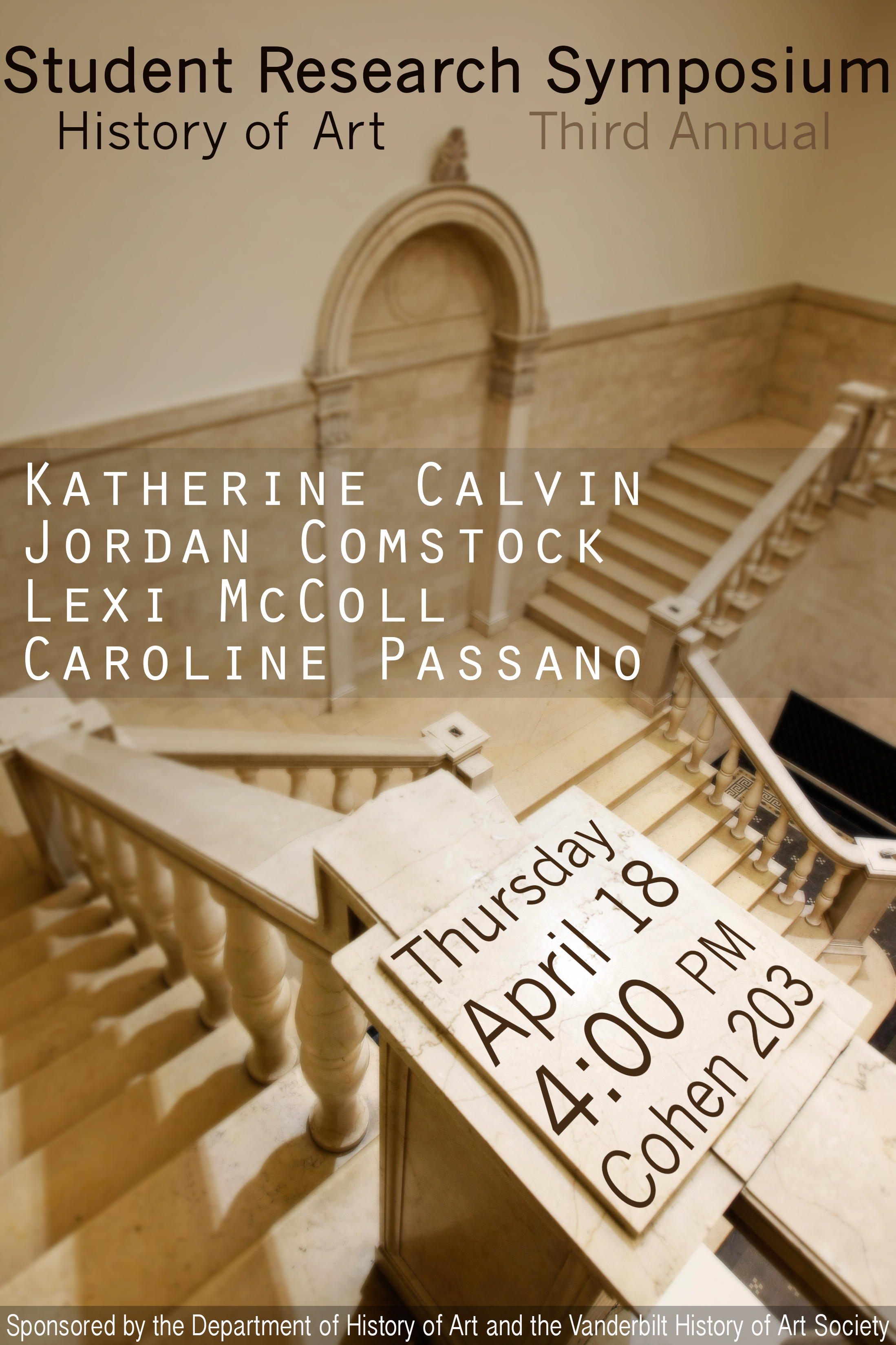 Graduating seniors and history of art majors Katherine Calvin, Jordan Comstock, Lexi McColl, and Caroline Passano are the featured speakers at the third annual Student Research Symposium on Thursday, April 18, at 4:00 p.m. in Cohen 203. A reception in the atrium will immediately follow the symposium.
Graduating seniors and history of art majors Katherine Calvin, Jordan Comstock, Lexi McColl, and Caroline Passano are the featured speakers at the third annual Student Research Symposium on Thursday, April 18, at 4:00 p.m. in Cohen 203. A reception in the atrium will immediately follow the symposium.
Sponsored by the Department of History of Art and the Vanderbilt History of Art Society, the symposium is open to the public and will be documented on video for future posting on the departmental website.
Posted by vrcvanderbilt on April 16, 2013 in Events, HART, Lectures, Student/Alumni, VRC
Review of Camille Utterback’s Exhibit at the Frist through May 19
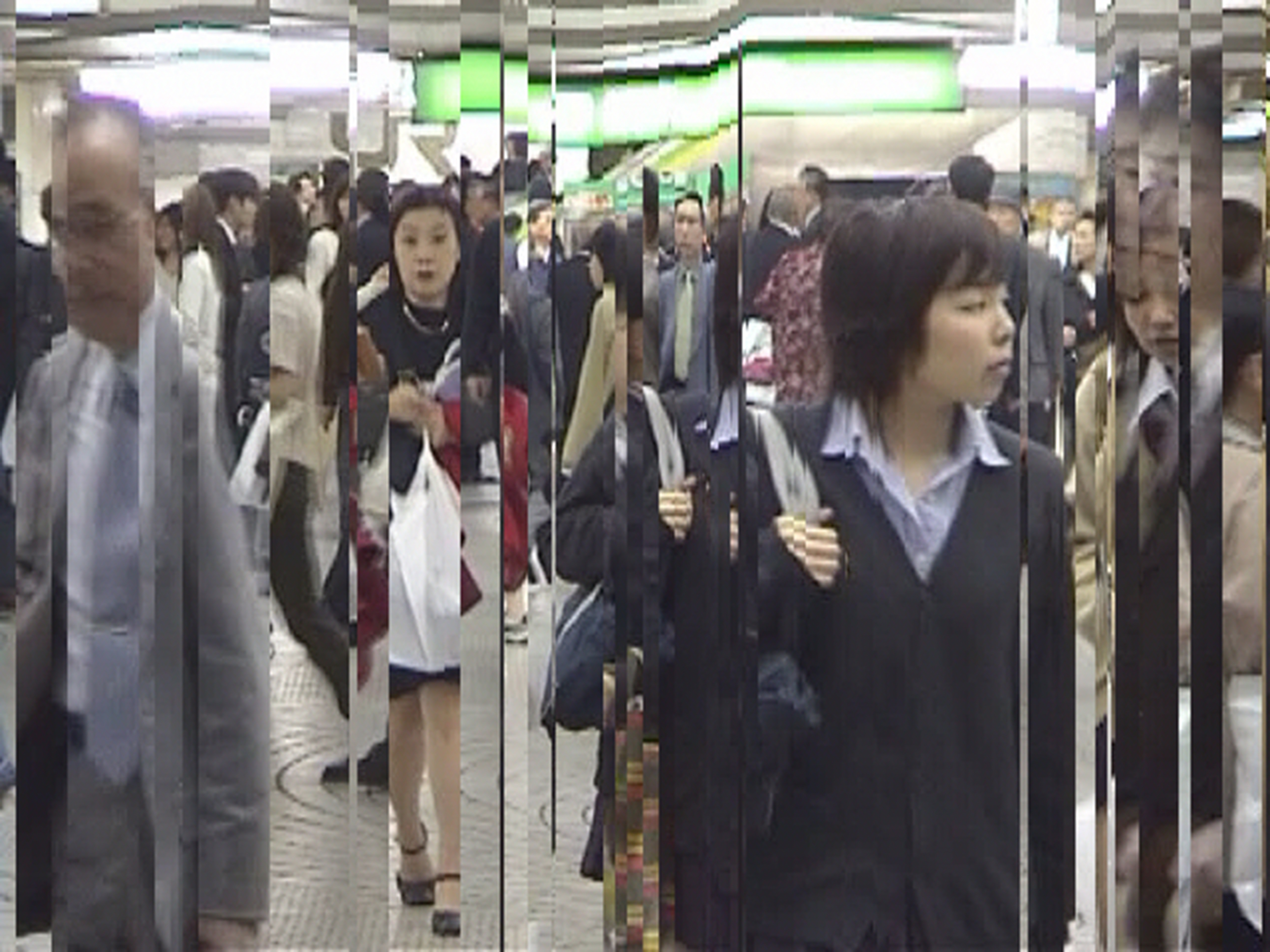 Camille Utterback’s exhibit, Tracing Time/Marking Movement, at The Frist Center for the Visual Arts in Nashville, Tennessee, offers a divergence from the typical museum visit; it allows each visitor to be both viewer and participant. The exhibition, on view through May 19, features seven works of art, four of which require interactivity.
Camille Utterback’s exhibit, Tracing Time/Marking Movement, at The Frist Center for the Visual Arts in Nashville, Tennessee, offers a divergence from the typical museum visit; it allows each visitor to be both viewer and participant. The exhibition, on view through May 19, features seven works of art, four of which require interactivity.
The first work that the viewer sees is Liquid Time—Tokyo (image 1). On initial glance, this work looks like an enlarged photograph, but as one moves toward the lighted square on the ground, the image begins to adjust, and the figures on the screen appear to move. The movements of the people in Tokyo directly correlate with the movements of the viewer in front of the screen. In Utterback’s demonstration, she revealed how the positioning of motion is crucial. She instructed a child to tap the floor on the lit area closest to the image. In doing so, a fragment of the image returned to the beginning of the frame, showing the figures as they walked toward their initial resting place. The size and contours of the viewer’s body reflect the degree to which the image adjusts. Through play and exploration, the viewer can experience the full potential of the effect of one’s body on the image.
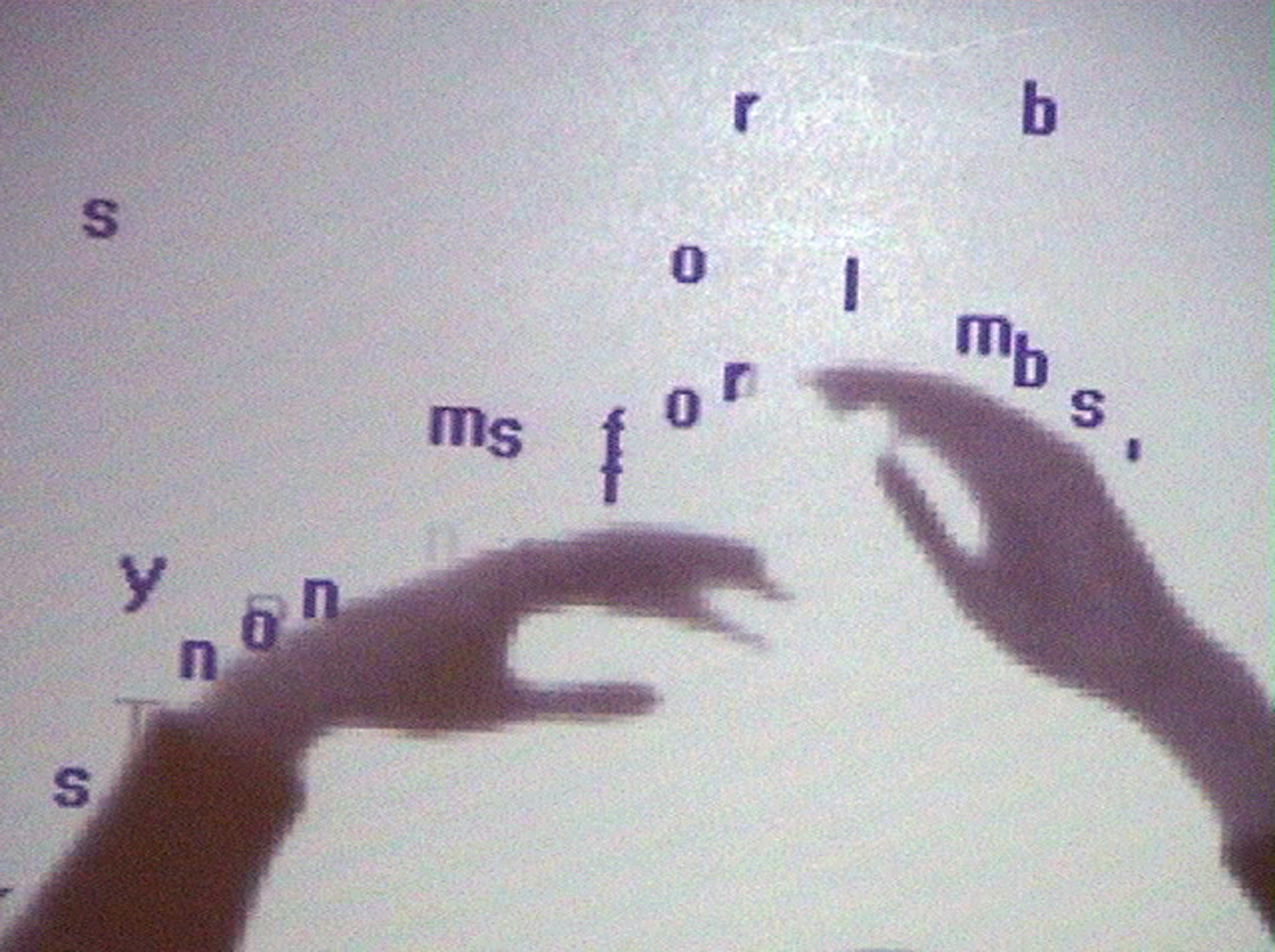 This same concept of learning through interaction is further realized as one moves into the next room. Text Rain (image 2) projects the viewer’s body onto the screen. Letters fall onto the outline of the viewer’s shape. Lighter colored letters disappear as they fall down, while the letters with darker hues easily keep floating. With Text Rain, Utterback challenges previous conceptions of the use of words by adding a physical element. Robert Simanowski notes, “The letters are liberated from their representational function. They have left language behind and turned into visual objects as part of an interactive installation.” (Digital Anthropophagy, 159).
This same concept of learning through interaction is further realized as one moves into the next room. Text Rain (image 2) projects the viewer’s body onto the screen. Letters fall onto the outline of the viewer’s shape. Lighter colored letters disappear as they fall down, while the letters with darker hues easily keep floating. With Text Rain, Utterback challenges previous conceptions of the use of words by adding a physical element. Robert Simanowski notes, “The letters are liberated from their representational function. They have left language behind and turned into visual objects as part of an interactive installation.” (Digital Anthropophagy, 159).
In the room to the right of the central room, large projections of color reveal themselves to the visitor. These are Utterback’s most recent installations, Untitled 5 and Untitled 4 (image 3). Marianne Adams describes the experience as follows: “Simply by moving or gesturing in the space in front of these images, participants can change them, altering their colors, patterns, and shapes.” (The Dilemma of Interactive Art Museum Spaces, 46). 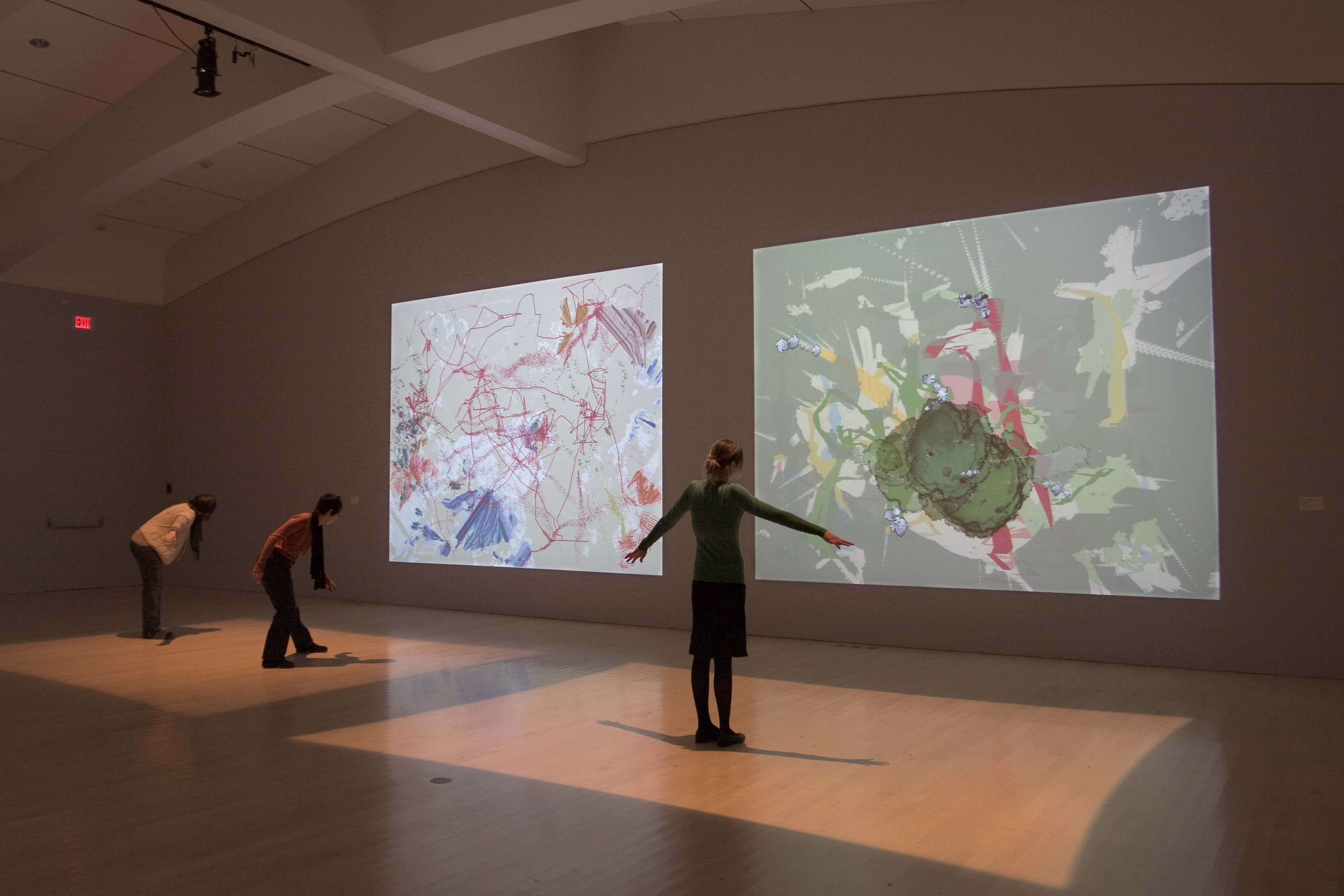 As the quotation suggests, Untitled 5 and Untitled 4 differ from Text Rain and Liquid Time—Tokyo in that movement does not fragment a stable image but creates new images. By waving an arm, color is splattered on the surface. By picking up a foot, that movement is then washed over with more color of a different palette.
As the quotation suggests, Untitled 5 and Untitled 4 differ from Text Rain and Liquid Time—Tokyo in that movement does not fragment a stable image but creates new images. By waving an arm, color is splattered on the surface. By picking up a foot, that movement is then washed over with more color of a different palette.
In these two installations, it becomes clear that the viewer is the artist. Nathaniel Stern suggests, “Her installations are not objects to be perceived but relations to be performed.” (The Implicit Body as Performance, 233). As Stern proposes, the artist is now not the only factor in control of the work of art. In effect, this installation allows for every viewer to be the artist. The visitors not only get to see art, but create it.
Three other works hang on the walls of the third room. They consist of altering shapes, forms, and colors. However, despite their mutating states, these works do not suit the rest of the exhibit. Their small size stands in stark contrast with the enormous interactive installations. Additionally, their lack of interactivity is confusing to the visitor. After enjoying four interactive images, one becomes accustomed to the expectation of interactivity. Discovering that these last three works do not require participation is a disappointment. They clutter the gallery space, rather than enhance it.
Despite these failings, the exhibition is entertaining. Through the setup of the exhibition and subsequent installations, the viewer is encouraged to explore his body motions and see the effects displayed before him. Utterback’s exhibit invokes curiosity and a desire to learn more. Yet, she achieves this desire by giving each viewer a novel experience. No two visitors will see the same images. More than that, this exhibit allows the viewer to share the artistic creativity with the artist. No longer is the work of art solely a creation of the artist; it is a result of the participant, too. While playing with her exhibitions, it is hard not to raise questions about what art really is and what one’s relation to it should be. In this regard, Utterback’s exhibit is successful because it questions the traditional view of the artist and one’s own conception of art.—Robyn Christine Taylor
Works Cited:
Adams, Marianna, Cynthia Moreno, et al. “The Dilemma of Interactive Art Museum Spaces.” Art Education. 56.5. Print.
Simanowski, Roberto. “Digital Anthropophagy: Refashioning Words as Image, Sound and Action.” Leonardo. 43.2 Print.
Stern, Nathaniel. “The Implicit Body as Performance: Analyzing Interactive Art.” Leonardo. 44.3. Print.
Image 1: Camille Utterback. Liquid Time—Tokyo (screen detail), 2001. Interactive installation; custom software, video camera, computer, projector, and lighting. Courtesy of the artist.
Image 2: Camille Utterback and Romy Achituv. Text Rain (screen detail), 1999. Interactive installation; custom software, video camera, computer, projector, and lighting. Courtesy of the artists.
Image 3: Camille Utterback. Untitled 5 (installation view), 2004. Interactive installation; custom software, video camera, computer, projector, and lighting. Courtesy of the artist. Photography by Tom Bamberger.
Posted by vrcvanderbilt on April 15, 2013 in HART, Student/Alumni, VRC
Free Coffee Available in the VRC Now Through Final Exams
 As the spring semester comes to a close, the Visual Resources Center invites students, faculty, and staff to join us for a free cup of coffee—or two or three—in Cohen 134. Coffee will be available throughout the day for the next two weeks, beginning Monday, April 15, through Thursday, May 2. Pour yourself a cup and dash to class or stay for a while and review images streaming across the big screen at the end of our large study table or simply sit down and take some time to relax and enjoy a cup of java. The VRC is open weekdays from 7:30 a.m. to 6:00 p.m.
As the spring semester comes to a close, the Visual Resources Center invites students, faculty, and staff to join us for a free cup of coffee—or two or three—in Cohen 134. Coffee will be available throughout the day for the next two weeks, beginning Monday, April 15, through Thursday, May 2. Pour yourself a cup and dash to class or stay for a while and review images streaming across the big screen at the end of our large study table or simply sit down and take some time to relax and enjoy a cup of java. The VRC is open weekdays from 7:30 a.m. to 6:00 p.m.
Posted by vrcvanderbilt on April 12, 2013 in Events, HART, VRC
Vivien Fryd to Present Talk in Berlin on Henry Ries and Her Family
 Vivien Green Fryd, professor of history of art, will give a talk in Berlin on April 11 entitled A Non-Fictional Thriller: Henry Ries, the Quakers, the State Department and My Mother’s Dramatic Rescue from Nazi Germany. Fryd, niece of the New York Times photographer Henry Ries (1917-2004), will speak at the John F. Kennedy Institut für Nordamerikastudien at the Freie Universität, Berlin.
Vivien Green Fryd, professor of history of art, will give a talk in Berlin on April 11 entitled A Non-Fictional Thriller: Henry Ries, the Quakers, the State Department and My Mother’s Dramatic Rescue from Nazi Germany. Fryd, niece of the New York Times photographer Henry Ries (1917-2004), will speak at the John F. Kennedy Institut für Nordamerikastudien at the Freie Universität, Berlin.
Ries, a Berlin-born Jew who fled Hitler with his sister (Fryd’s mother) in 1938, returned to Germany after the war and often used images of mundane life to contrast the darkness of war’s aftermath. Among his most evocative pictures of postwar Germany are his images of the Berlin airlift in 1948 and 1949.
Posted by vrcvanderbilt on April 9, 2013 in HART, Lectures, VRC
Johns to Chair Session at Eighteenth-Century Studies Meeting
Christopher Johns, Norma L. and Roselea J. Goldberg Professor of History of Art, will chair the “Anne Schroder New Scholars Session” on Friday, April 5, at the 44th annual meeting of the American Society for Eighteenth-Century Studies held in Cleveland, Ohio. The session showcases the current research of four young art historians and is named in honor of the late Prof. Anne Schroder, a specialist in the art and visual culture of eighteenth-century France.
Posted by vrcvanderbilt on April 1, 2013 in Events, HART, VRC
Destruction and Desecration of Images of Classical Antiquity
 The Archaeological Institute of America lecture series will conclude this semester with the Joukouwski Lecture delivered by John Pollini, professor of classical art and archaeology in the department of art history at the University of Southern California. His lecture, entitled “Destruction and Desecration of Images of Classical Antiquity,” will be held on Thursday, April 4, at 7:00 p.m. in the Nashville Parthenon in Centennial Park.
The Archaeological Institute of America lecture series will conclude this semester with the Joukouwski Lecture delivered by John Pollini, professor of classical art and archaeology in the department of art history at the University of Southern California. His lecture, entitled “Destruction and Desecration of Images of Classical Antiquity,” will be held on Thursday, April 4, at 7:00 p.m. in the Nashville Parthenon in Centennial Park.
In popular culture Christianity is remembered for the art, architecture, customs, rituals, and myths that it preserved from the classical past. It is rarely acknowledged, however, that Christianity also destroyed a great deal in its conversion of the Roman Empire. The material evidence for Christian destruction has often been overlooked or gone unrecognized even by archaeologists. Pollini will examine various forms of Christian destruction and desecration of images of classical antiquity during the fourth to seventh centuries as well as some of the attendant problems in detecting and making sense of this phenomenon.
Pollini received both his M.A. and Ph.D. from the University of California at Berkeley in the interdepartmental program in ancient history and Mediterranean archaeology. At the University of Southern California, where he has taught since 1987, he has served as chair of the department and as dean of the School of Fine Arts. His areas of specialization are Roman art and archaeology, ancient religion and propaganda. He has received numerous fellowships and awards, including a Guggenheim Foundation Fellowship, two American Council of Learned Societies Fellowships, two National Endowment for the Humanities Fellowships, and a Fulbright Fellowship to Italy.
To be published this year is his latest book, From Republic to Empire: Rhetoric, Religion, and Power in the Visual Culture of Ancient Rome. His current book project is titled Christian Destruction and Desecration of Images of Classical Antiquity: A Study in Religious Intolderance and Violence in the Ancient World.
Free and open to the public, the lecture is sponsored by the Archaeological Institute of America, the Conservancy for the Parthenon and Centennial Park, the Vanderbilt History of Art Goldberg Lecture Series, the Department of Classical Studies, and the Holiday Inn at Vanderbilt. Those who plan to attend the lecture are encouraged to call the Nashville Parthenon at 615.862.8431 to reserve a seat.
Posted by vrcvanderbilt on April 1, 2013 in HART, Lectures, VRC
Robin Jensen Appeared on CBS Sunday Morning on March 31
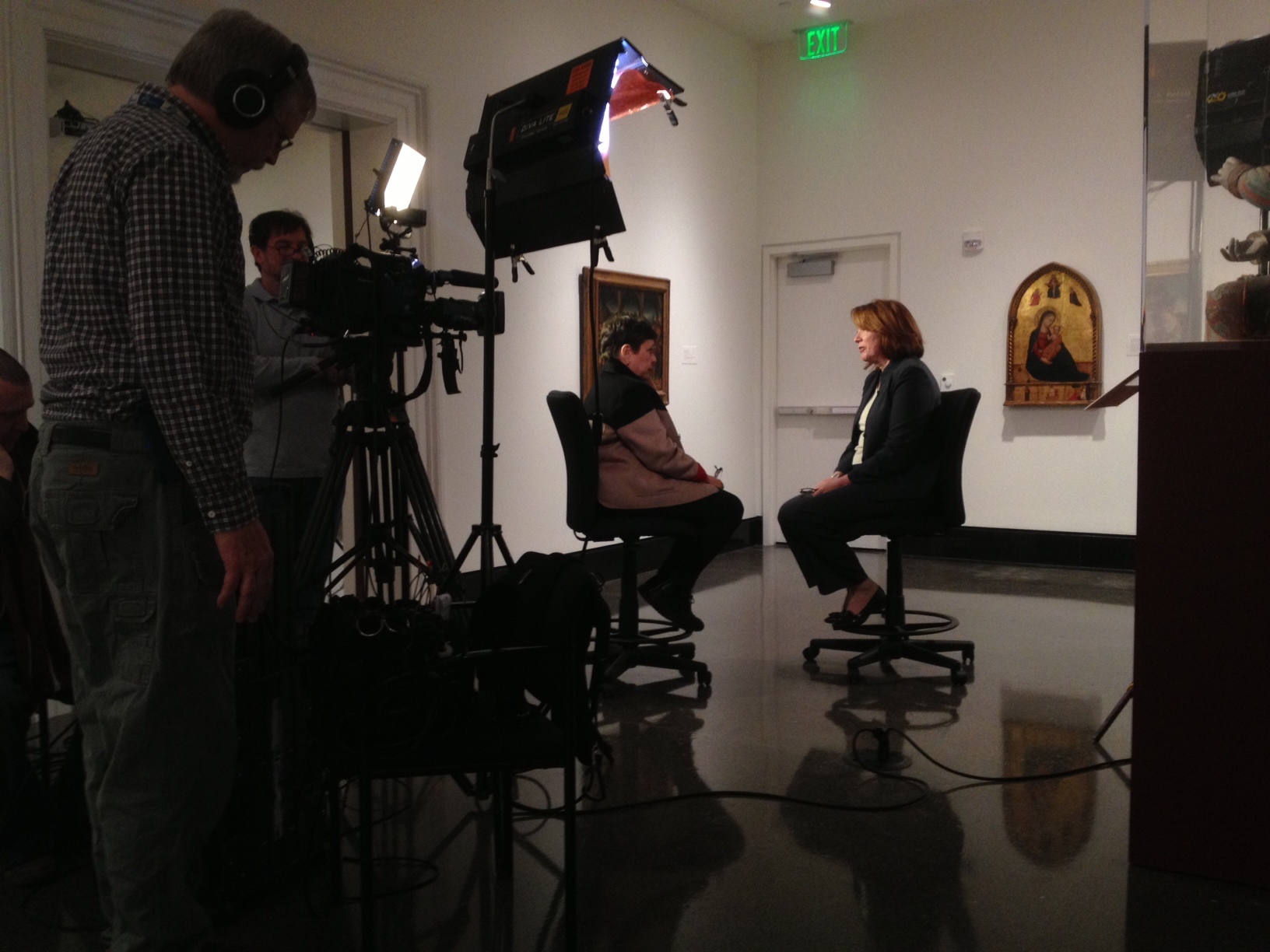 The CBS Sunday Morning video crew arrived early the morning of March 26 to set the stage for an interview in the Vanderbilt Fine Arts Gallery with Robin Jensen, Luce Chancellor’s Professor of the History of Christian Art and Worship at Vanderbilt University.
The CBS Sunday Morning video crew arrived early the morning of March 26 to set the stage for an interview in the Vanderbilt Fine Arts Gallery with Robin Jensen, Luce Chancellor’s Professor of the History of Christian Art and Worship at Vanderbilt University.
Interviewed by CBS News correspondent Martha Teichner, Jensen was featured on CBS Sunday Morning on March 31 as part of the cover story that aired on Easter Sunday. Teichner interviewed Jensen about the depiction of the Virgin Mary in art. Jensen also described some of the images of Mary—seven paintings from the Samuel Kress Collection—that are on view in the gallery as part of the Vanderbilt University Art Collection. Follow this link to the segment of CBS Sunday Morning that featured Jensen.
Jensen teaches courses in both the History of Art department and the Divinity School, among them, a course entitled “Mary, the Magdalene, and Eve in Christian Art, Text, and Tradition.” Most of her research and publication focuses on the interpretation of early Christian art and architecture in light of its theological significance, ritual performance, and cultural context. Her courses include introductions to Jewish and Christian pictorial hermeneutics; visual representations of God, the Trinity, Christ, the Virgin Mary, and the saints; the religious art of Late Antiquity; and the art of the early Roman empire.
Her most recent books are Living Water: Images, Symbols, and Settings of Early Christian Baptism (Brill, 2011), and Baptismal Imagery in Early Christianity (Baker Academic, 2012). Other books include Understanding Early Christian Art (Routledge, 2000); Face to Face: Portraits of the Divine in Early Christianity (Fortress, 2005) and The Substance of Things Seen: Art, Faith and the Christian Community (Eerdmans, 2004); She was also a contributing editor and essayist to Picturing the Bible: The Earliest Christian Art (Yale, 2008), and co-editor of Visual Theology (Liturgical Press, 2010).
Posted by vrcvanderbilt on March 27, 2013 in Fine Arts Gallery, HART, VRC
Christopher Johns Invited to Lecture at San Diego Museum of Art
 Christopher Johns, Norma L. and Roselea J. Goldberg Professor of History of Art, has been invited to lecture on March 30 at the symposium Piranesi, Rome, and the Arts of Design held in conjunction with the eponymous exhibition at the San Diego Museum of Art. His lecture, Piranesi and the Fabrication of Rome in the European Imagination: Le Vedute di Roma and Antichità Romane, will explore the connection between word and image and between image and reality in Piranesi’s influential series with the intention of shedding some light on the disconnection between the scholar’s and the tourist’s Rome in the middle decades of the eighteenth century.
Christopher Johns, Norma L. and Roselea J. Goldberg Professor of History of Art, has been invited to lecture on March 30 at the symposium Piranesi, Rome, and the Arts of Design held in conjunction with the eponymous exhibition at the San Diego Museum of Art. His lecture, Piranesi and the Fabrication of Rome in the European Imagination: Le Vedute di Roma and Antichità Romane, will explore the connection between word and image and between image and reality in Piranesi’s influential series with the intention of shedding some light on the disconnection between the scholar’s and the tourist’s Rome in the middle decades of the eighteenth century.
The vast majority of Europeans who studied, collected and admired the graphic works of Giambattista Piranesi never saw Rome. This fabricated Rome inspired the European imagination in a way that is difficult to understand in the modern age of imagery overload and instantaneous access to almost everything. But Piranesi’s Rome was a reality in its own right, and only those relative few who actually visited the Eternal City during their Grand Tours could compare the artist’s vision with diurnal reality. Indeed, not a few Roman visitors, conditioned by their study of Piranesi’s imagery, were disappointed in the modest scale and shabby surroundings of some of the greatest monuments to survive from an admired antiquity. The Views of Rome and Roman Antiquities, two of the artist’s most influential series of etchings, had an exceptionally high profile in Enlightenment Europe and form the basis for his vision of Roman magnificence.
*Giambattista Piranesi, View of the Subterranean Foundations of the Mausoleum Built by the Emperor Hadrian, from Le Antichità Romane, etching, ca. 1756.
Posted by vrcvanderbilt on March 22, 2013 in HART, VRC
Kevin Murphy Named History of Art Department Chair
The History of Art Department announces the appointment of Kevin Murphy, John Rewald Professor of Art History and Executive Officer of the Ph.D. Program in Art History at the Graduate School and University Center, City University of New York, as the new department chair beginning fall semester 2013. Professor Murphy (PhD, Northwestern University, 1992) has written on historicism in the United States and France in the nineteenth and twentieth centuries as well as on American material culture.
Professor Murphy’s work has considered the variety of expressions of historicism in historic preservation projects, in the representation of medieval architecture in modernist painting, and in architectural historiography. He has written on French architect and theorist Eugène-Emmanuel Viollet-le-Duc, on the Colonial Revival in the United States, and on the historiography of early American architecture. He is currently researching a book that will use the figure of Lafayette as a starting point for a consideration of memorializing republics in the Revolutionary Atlantic.
Among his publications are Jonathan Fisher of Blue Hill, Maine: Commerce, Culture and Community on the Eastern Frontier (University of Massachusetts Press, 2010), The Houses of Greenwich Village (Harry N. Abrams, 2008), The American Townhouse (Harry N. Abrams, 2005), and Colonial Revival Maine (Princeton Architectural Press, 2004). He recently edited (with Sally O’Driscoll) Ephemera: Text and Image in Eighteenth-Century Print (Bucknell University Press, 2013). Forthcoming is an article in the Journal of Urban History entitled “The Historic Building in the Modernized City: The Cathedrals of Paris and Rouen in the Nineteenth Century.”
Professor Murphy has also taught in the School of Architecture at the University of Virginia. He has held Fulbright, Chateaubriand, and National Gallery of Art fellowships, a Graham Foundation grant, and has been a Chester Dale Fellow at the Metropolitan Museum of Art.
Posted by vrcvanderbilt on March 22, 2013 in HART, VRC
Huey Copeland to Deliver Goldberg Lecture on March 14
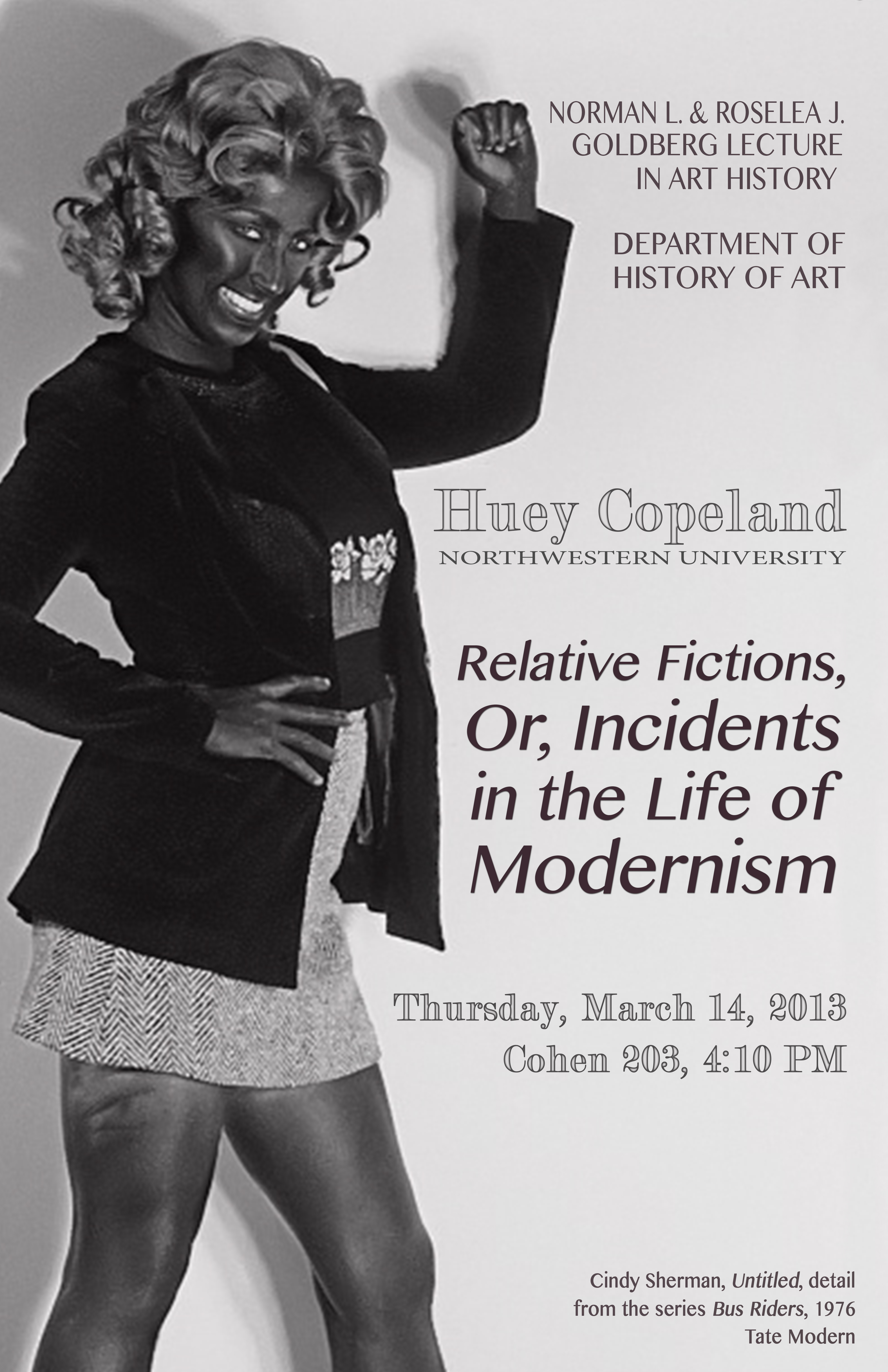 Huey Copeland, director of graduate studies and associate professor of art history at Northwestern University, will present the spring 2013 Norman L. and Roselea J. Goldberg Lecture in Art History on Thursday, March 14, at 4:10 p.m. in 203 Cohen Hall. In his lecture, Relative Fictions, or, Incidents in the Life of Modernism, drawn from his next book project, Copeland will examine the negress—a key figure of Western artistic production—in order to newly interpret the practices that have both shaped the visual predication of black femininity and constituted modernist aesthetic form.
Huey Copeland, director of graduate studies and associate professor of art history at Northwestern University, will present the spring 2013 Norman L. and Roselea J. Goldberg Lecture in Art History on Thursday, March 14, at 4:10 p.m. in 203 Cohen Hall. In his lecture, Relative Fictions, or, Incidents in the Life of Modernism, drawn from his next book project, Copeland will examine the negress—a key figure of Western artistic production—in order to newly interpret the practices that have both shaped the visual predication of black femininity and constituted modernist aesthetic form.
Copeland also has affiliations at Northwestern in the Department of African American and African Diaspora Studies and the Program in Gender and Sexuality Studies. His work focuses on modern and contemporary art with emphases on the articulation of blackness in the American visual field and the intersections of race, gender, and sexuality in Western aesthetic practice broadly construed. A regular contributor to Artforum, Copeland has also published in Art Journal, Callaloo, Parkett, Qui Parle, Representations, and Small Axe, as well as in numerous edited volumes and international exhibition catalogues, including the award-winning Modern Women: Women Artists at the Museum of Modern Art.
Most notable among his forthcoming publications is Bound to Appear: Art, Slavery, and the Site of Blackness in Multicultural America, a book funded by a Creative Capital/Warhol Foundation Arts Writers Grant that will be published by the University of Chicago Press. Focused on the work of Renée Green, Glenn Ligon, Lorna Simpson, and Fred Wilson, this project considers how slavery shaped American art in the last decades of the twentieth century in order to argue for a reorientation of modern and contemporary art history where the subject of race is concerned. The book, like much of Copeland’s work, derives from research into theories of subject formation, twentieth-century sculpture, histories of slavery, gender and sexual difference, site-specific practices, and African American cultural discourse.
Alongside his work as a teacher, critic, and scholar, Copeland has co-curated such exhibitions as Interstellar Low Ways at the Hyde Park Art Center and co-edited journal volumes such as New World Slavery and the Matter of the Visual. An alumnus of the 2002-2003 Whitney Independent Study Program, he has also received support from the Alice Kaplan Institute for the Humanities, the American Council of Learned Societies, the Georgia O’Keeffe Museum Research Center for American Modernism, the Northwestern University Research Grants Committee, and the Terra Foundation for American Art. In 2011 he was a residential fellow at Harvard University’s W.E.B. Du Bois Institute for African and African American Research, where he continued work on In the Arms of the Negress, a book that explores the constitutive role of black femininity in Western art from the nineteenth century to the present.
Sponsored by Vanderbilt’s Department of History of Art, the lecture is free and open to the public, and limited parking is available in Lot 95 outside Cohen Hall, off 21st Avenue South on the Peabody campus and across from Medical Center East.
Posted by vrcvanderbilt on March 4, 2013 in HART, Lectures, VRC

©2025 Vanderbilt University ·
Site Development: University Web Communications